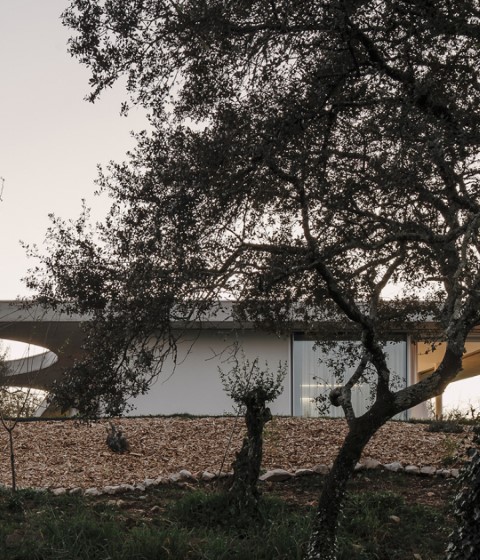Castroferro Arquitectos enhances the house with a space enriched by its possible open and closed routes, facing the exterior landscape of the urbanization that surrounds it. A space that is transformed upon arrival and crossing the defensive perimeter wall to access the house, understood as a home, "as a final resting point".
The space of the house welcomes us with a superior view of the courtyard of the house, from which the tops of three cork oaks emerge, with their delicate leaves, while a concrete surface (as the guiding thread of the path), accompanies us and leads us under the idea of "corbuserian promenade", making the project a tour of sensory sequences.
The concrete walls, through the marks made by the formwork tables, dialogue with the pine carpentry that receives us through a walkway to introduce us to the house, which shows us its intimate landscapes and its three levels connected by the staircase and element that The route changes and gives us access to a spacious living room, whose large windows project the gaze towards the west area of the plot.
The materialization intentionally uses a reduced palette of materials, basically reinforced concrete and pine carpentry, which is completed with large pieces of granite to solve the rest of the situations, on the façade or on the flooring and cladding of a large part of the interior of the house.

Casamérica by Castroferro Arquitectos. Photograph by Héctor Santos-Díez.

Casamérica by Castroferro Arquitectos. Photograph by Héctor Santos-Díez.
Description of project by Castroferro Arquitectos
The journey as a strategy
We always had a special interest in transitions, the events that happen between two acts. Those moments, in these times, are usually treated as mere gaps between full assumptions.
Get home
Perhaps this has been the most important thread that we have followed to develop this project, to think of the house as a final point of rest that we end up reaching and it is that path that we decided to project.
In a certain way, this idea of the "promenade" corbuserian, that of the project as a path of sensory sequences accompanies us, although it makes us blush to say it out loud because they are very high words.
Thus, we describe this project from its arrival where after perceiving its resounding, rough and to a certain extent surly closure for those who look at it, when crossing said barrier we are received by three cork oak cups, with its fine leaf while a concrete slab (that material that acts as a conductive thread throughout the road) protects us.
Being received by the superior vision of the patio of the house, with treetops at our eye level allows us to recover the close scale, abandoning the fast and somewhat distracted rhythm that surrounds our day to day.

Casamérica by Castroferro Arquitectos. Photograph by Héctor Santos-Díez.
We are on the house's threshold. That protected place prior tentrance but which is already part of it, of its architecture, one of those transitional spaces on which so much architecture has been referenced.
Pine door, recalling the marks that other boards have left on the concrete, opens onto a hall, converted into a walkway.
We are already inside the house, walking along the walkway that accompanies us if we look to the left over the courtyard of the cork oaks or if we look down to the right at a nearby landscape of small bushes. Each one will decide what they prefer to watch.
It will be the staircase, connecting the three levels of the house that closes that first room of the house, the cork oak patio area has been left behind to now present the house with a new aspect of relationship with the outside on its west side.
It will be this area of relationship with the western part of the plot that we can understand as the end of the journey that began, we do not know where, at the moment we decided to return home. A spacious, resounding and clear living room opens onto the play area of the plot through large windows that, emphasized by the continuity of the ground that invades the pool, allow us to experience the house with an extreme connection with the outside.

Casamérica by Castroferro Arquitectos. Photograph by Héctor Santos-Díez.
Patio as a place of introversion
As the mood is changeable, more than it weighs on us, we liked that house also offered us a place where we could retire. An intimate, introverted, secluded place... and that is where that patio that at the entrance of the house offered us the treetops to receive us, now gathers us with three powerful concrete walls to give us a patio, a classic place of transition that we have admired so much.
A beautiful granite bleacher seeks to facilitate the events that may happen there, from the jubilation of the group to the moment of solitude.
This is how we like to think of this project, from its routes, transitions and spaces "between".
Project in its materialization seeks a deliberate emphaticness as well as a scant palette of materials, being reinforced concrete the one that guides the entire project with its marked board formwork that, we see replicated in the pine of the carpentry and the closure.
Some fantastic pieces of granite will solve the rest of the situations, either with a beautiful groove when it is a facade or, that same stone in large slabs solves the flooring and cladding of a large part of the interior of the house.











































